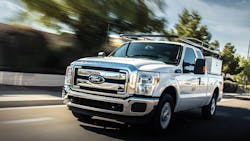The Environmental Protection Agency (EPA) reports that the transportation sector contributes more end-user emissions of greenhouse gases (GHG) than any other sector. Light-duty vehicles account for the majority of those transportation emissions, with medium-duty vehicles (and heavy-duty trucks) following closely behind. Through that lens, it makes sense that the conversion of fleet vehicles to electrofuels is often discussed as a near-term opportunity for the acceleration of decarbonization. In a perfect world, 100% renewable power generation would fuel electrified vehicles with zero end-user emissions.
But there is still much work to be done around how electricity is currently generated, stored, transmitted, and consumed for electric fleet vehicles to be considered truly sustainable. (In fact, the same EPA data shows that the electricity sector itself is the second-largest source of greenhouse gas emissions behind transportation—more than the agricultural, residential, and commercial sectors combined.) While this is the vision that our country is working toward, and the combination of technological progress and government incentives is likely to speed up our momentum, realistically it will be some time before we can get to true fleet vehicle decarbonization if electrofuels are treated as the sole solution.
Propane autogas vehicles are already operating safely and reliably in our communities. All over the country, propane autogas fuels light-duty fleets like law enforcement vehicles, taxicabs, and construction vehicles, as well as medium-duty delivery vehicles, trucks, and even buses for schools and public transit. The use of propane autogas in these vehicles virtually eliminates end-user nitrous oxide and greenhouse gas emissions while offering reduced maintenance costs, more uptime, and easy refueling without the need for expensive infrastructure. These vehicles can make an immediate impact on a fleet’s carbon footprint without impacting performance or adding significant operational costs.
To quantify the role that propane-fueled fleet vehicles can play in accelerating decarbonization—specifically as compared to electric vehicles—the Propane Education and Research Council recently conducted a thorough life-cycle analysis. This study compared equivalent carbon dioxide (CO2eq) emissions between a medium-duty (Class 6-7) electric vehicle and an analogous propane-fueled vehicle on a state-by-state level. The full report—and all assumptions and scenarios accounted for—is available here.
The key observations of this report reveal an alternative path to fleet decarbonization.
In most states, a propane-fueled medium- or heavy-duty vehicle provides a lower carbon footprint than an equivalent electric vehicle. With renewable energy penetration only accounting for 18% of the United States national grid, electric vehicles are still largely powered by energy mixes with high GHG outputs. Therefore, emissions calculations that don’t factor in the total life-cycle emissions paint only a partial picture of the vehicle’s footprint. When the total CO2eq life-cycle emissions are considered, propane fleet vehicles provide a more favorable carbon footprint than electric fleet vehicles in 38 states plus the District of Columbia.
When renewable propane autogas is used, propane-fueled vehicles provide a lower carbon footprint than EVs in 49 states. Because of Vermont’s disproportionate use of renewable energy sources to power its electric grid, this is the only state where the full life-cycle emissions of an electric fleet vehicle are currently cleaner than a medium-duty fleet vehicle running on renewable propane autogas. But in all other states, the renewable propane vehicle will have lower total CO2eq emissions over its life than the electric.
Blending renewable DME with propane autogas can even further lower a medium-duty vehicle’s carbon footprint in 49 states. Dimethyl ether (DME) is a compound that can lower the carbon intensity of gas fuels, lowering carbon emissions without sacrificing performance. When blended with propane autogas (at 80% to 20% by mass) this blend lowers emissions even more dramatically than an equivalent vehicle powered by an electric grid. Again, this is true in all states except Vermont, whose grid is powered more renewably than most other states.
When both DME additive and propane autogas are produced from renewable sources, medium-duty propane vehicles have a lower carbon footprint than electric vehicles in all 50 states. Propane autogas is increasingly being produced from upcycled fats, oils, greases, and residues—without the need for expensive infrastructure investment. When the carbon footprint of propane autogas is reduced by both renewable sourcing and renewable DME additive, the total life-cycle CO2eq emissions are lower than a grid-powered medium-duty electric vehicle in every state.
In fact, even in an “ideal” future scenario with enhanced electric technology, a blend of renewable propane autogas and renewable DME would still enable a lower carbon footprint than an equivalent medium-duty EV—nationally. In one scenario, the study imagined an ultra-efficient electric grid where reliance on carbon is reduced by 95% and cutting-edge lithium-ion batteries are manufactured with zero-carbon energy sources to last a minimum of a million miles. Even under these hypothetical circumstances, renewable propane autogas blended with renewable DME would still produce lower CO2eq emissions over the life-cycle of a medium-duty vehicle in all 50 states.
This study underscores a fundamental problem with our national conversation around decarbonization: eliminating emissions from the vehicle does not mean eliminating emissions from the vehicle’s full life-cycle, and these bigger picture perspectives need to be included in emissions comparisons for a more accurate analysis. This will be our national challenge until the penetration of renewable energy in our grid system hits a sustainable tipping point in the coming decades.
But light- and medium-duty vehicles fueled by propane autogas can make a massive improvement on your fleet’s emissions today. As propane autogas technology continues to improve at a faster pace than electric infrastructure improvements, renewable propane and renewable DME additives will only continue to lower the emissions of your fleet vehicles across their life-cycle.
